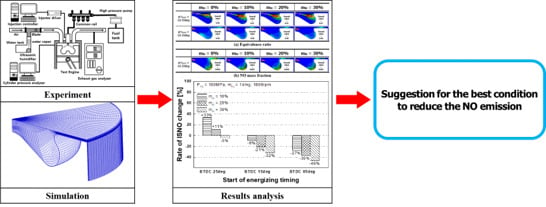Effect of Water Vapor Injection on the Distributions of Equivalence Ratio and the NO Emission Reduction in a CI Engine
Abstract
1. Introduction
2. Experimental and Numerical Descriptions
2.1. Experimental Setup
2.2. Numerical Sub-Model
2.3. Experimental and Numerical Conditions
3. Results and Discussions
3.1. Validation of Numerical Model
3.2. Effect of Water Vapor Injection on the Distributions of the Equivalence Ratio and the Exhaust Emissions in the Cylinder
3.3. Effect of Water Vapor Portion on Combustion Characteristics
3.4. Effect of the Portion of Water Vapor on Exhaust-Emission Characteristics
3.5. Effect of Water Vapor Portion on the ISFC Characteristics
4. Conclusions
- Without the water vapor injection, the area of rich equivalence ratio was distributed around the piston-rim region; however, with the water vapor injection, the area of rich equivalence ratio was more widely distributed in the center of cylinder, because the injected fuel collided with the remaining water particles.
- The ISNO value with water vapor injection was decreased up to 46% than without water vapor injection, because the combustion temperature was suppressed by the high specific heat and vaporization latent heat of water introduced into the cylinder.
- The difference of ISSoot values with or without the water vapor injection was difficult to observe because a small amount of soot was formed, although the oxidation reaction of soot with water vapor injection had deteriorated.
- In the cases of teng = BTDC 25deg and BTDC 15deg, the ISFC values decreased with the increasing water vapor portion, because the peak cylinder pressure occurred after TDC, which reduced the compression loss.
- In the case of teng = BTDC 05deg, the ISFC values were increased by increasing the water vapor portion, because the ignition delay was too long, which deteriorated combustion performance.
- From these results, injecting water vapor into the intake port of a CI engine can be expected to reduce ISNO by up to 46% than without injecting water vapor, while producing a similar ISSoot value as the conventional method.
Author Contributions
Funding
Acknowledgments
Conflicts of Interest
References
- Han, D.S.; Lee, B.H.; Bae, M.J.; Chang, Y.J.; Jeon, C.H.; Song, J.H. A Numerical Study on the Spray Characteristic of a Marine Diesel Engine of Injection Spray Angle and Hole Diameter. In Proceedings of the Trans. Korean Soc. Mech. Eng. Spring Conference, Jeongseon, Korea, 23–25 April 2008; pp. 572–577. [Google Scholar]
- Su, L.W.; Li, X.R.; Zhang, Z.; Liu, F.S. Numerical Analysis on the Combustion and Emission Characteristics of Forced Swirl Combustion System for DI Diesel Engines. J. Energy Convers. Manag. 2014, 86, 20–27. [Google Scholar] [CrossRef]
- Gafoor, A.; Gupta, R. Numerical Investigation of Piston Bowl Geometry and Swirl Ratio on Emission from Diesel Engines. J. Energy Convers. Manag. 2015, 101, 541–551. [Google Scholar] [CrossRef]
- Min, S.H.; Suh, H.K. The Effect of Nozzle Hole Geometry on the Small CI Engine Performances. In Proceedings of the ICAT Conference, Gwangju, Korea, 7–8 July 2016; p. 322. [Google Scholar]
- Park, S.W.; Reitz, R.D. A gas jet superposition model for CFD modeling of group-hole nozzle sprays. Int. J. Heat Fluid Flow 2009, 30, 1193–1201. [Google Scholar] [CrossRef]
- Hountalas, D.T.; Mavropoulos, G.C.; Binder, K.B. Effect of exhaust gas recirculation (EGR) temperature for various EGR rates on heavy duty DI diesel engine performance and emissions. J. Energy 2008, 30, 272–283. [Google Scholar] [CrossRef]
- Park, Y.S.; Bae, C.S. Experimental study on the effects of high/low pressure EGR proportion in a passenger car diesel engine. J. Appl. Energy 2014, 133, 308–316. [Google Scholar] [CrossRef]
- Han, M.B. The Effect of Cetane Number on Exhaust Emissions in Low-temperature Diesel Combustion. Trans. KSAE 2011, 19, 17–22. [Google Scholar]
- Wei, M.R.; Nguyen, T.S.; Turkson, R.F.; Liu, J.P. Water injection for higher engine performance and lower emissions. J. Energy Inst. 2017, 90, 285–299. [Google Scholar]
- Stanglmaier, R.H.; Dingle, P.J.; Stewart, D.W. Cycle-controlled water injection for steady-state and transient emissions reduction from a heavy-duty diesel engine. J. Eng. Gas Turbine Power 2008, 130, 3. [Google Scholar] [CrossRef]
- Park, S.K.; Woo, S.C.; Kim, H.I.; Lee, K.H. The characteristic of spray using diesel water emulsified fuel in a diesel engine. J. Appl. Energy 2016, 176, 209–220. [Google Scholar] [CrossRef]
- Chen, Z.B.; Wang, X.C.; Pei, Y.Q.A.; Zhang, C.L.; Xiao, M.W.; He, J.G. Experimental investigation of the performance and emissions of diesel engines by a novel emulsified diesel fuel. J. Energy Convers. Manag. 2015, 95, 334–341. [Google Scholar] [CrossRef]
- Ma, X.K.; Zhang, F.J.; Han, K.; Zhu, Z.X.; Liu, Y.Y. Effects of Intake Manifold Water Injection on Combustion and Emissions of Diesel Engine. J. Energy Procedia 2014, 61, 777–781. [Google Scholar] [CrossRef]
- Kokkulunk, G.K.; Gonca, G.V.; Ayhan, V.Z.; Cesur, I.; Parlak, A. Theoretical and experimental investigation of diesel engine with steam injection system on performance and emission parameters. J. Appl. Therm. Eng. 2013, 54, 161–170. [Google Scholar] [CrossRef]
- Xavier, T.; Alain, M.; Samiur, R.S. Experimental study of inlet manifold water injection on combustion and emissions of an automotive direct injection Diesel engine. J. Energy 2010, 35, 3628–3639. [Google Scholar]
- Min, S.H.; Suh, H.K. Reduction of NOX Emission in a CI Engine by using Specific Heat of H2O. In Proceedings of the Transactions of KSAE Spring Conference, Cheonan, Korea, 2 June 2017; pp. 70–72. [Google Scholar]
- AVL List GmbH. Fire Version 2013 ESE-Diesel (Engine Simulation Environment) Module Manual; AVL: Graz, Austria, 28 February 2013. [Google Scholar]
- AVL GmbH. Fire Version 2013 Combustion Module Manual; AVL: Graz, Austria, 30 September 2012. [Google Scholar]
- Liu, A.B.; Reitz, R.D. Modeling the Effects of Drop Drag and Breakup on Fuel Sprays. SAE Trans. J. Engines 1993, 102, 83–95. [Google Scholar]
- AVL List GmbH. Fire Version 2013.2 Spray Module Manual; AVL: Graz, Austria, 30 September 2014. [Google Scholar]
- Bosch, W. The Fuel Rate Indicator: A New Measuring Instrument for Display of the Characteristics of Individual Injection; SAE 1966 Transactions Vol. 75-A, 1966, SAE 660749; SAE International: Warrendale, PA, USA, 1966. [Google Scholar]
- Turns, S. An Introduction to Combustion: Concepts and Applications, 3rd ed.; McGraw-Hill, Inc.: New York, NY, USA, 2012. [Google Scholar]
- Cengel, Y.A.; Boles, M.A. Thermodynamics an Engineering Approach, 17th ed.; McGraw-Hill, Inc.: New York, NY, USA, 2011. [Google Scholar]

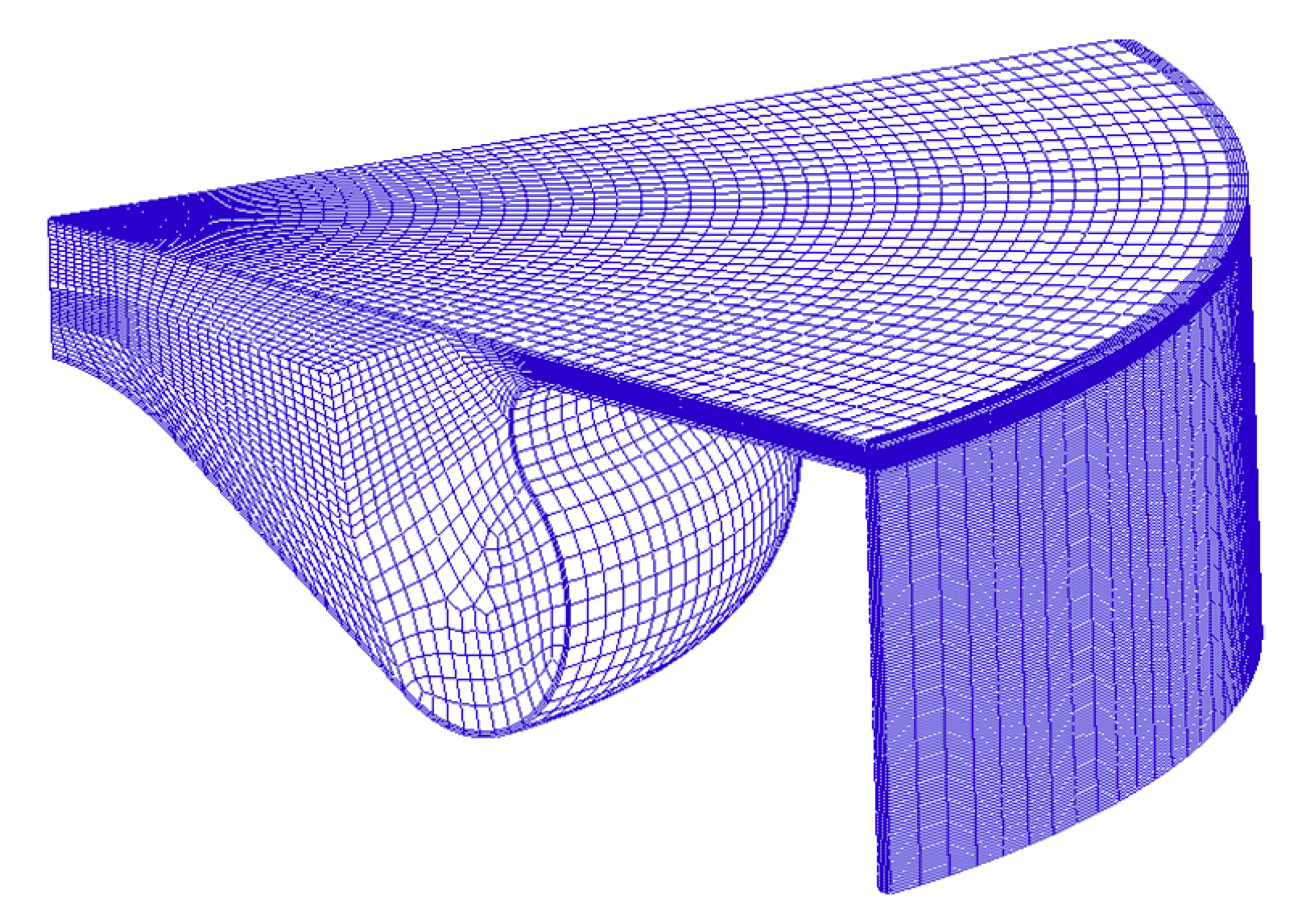
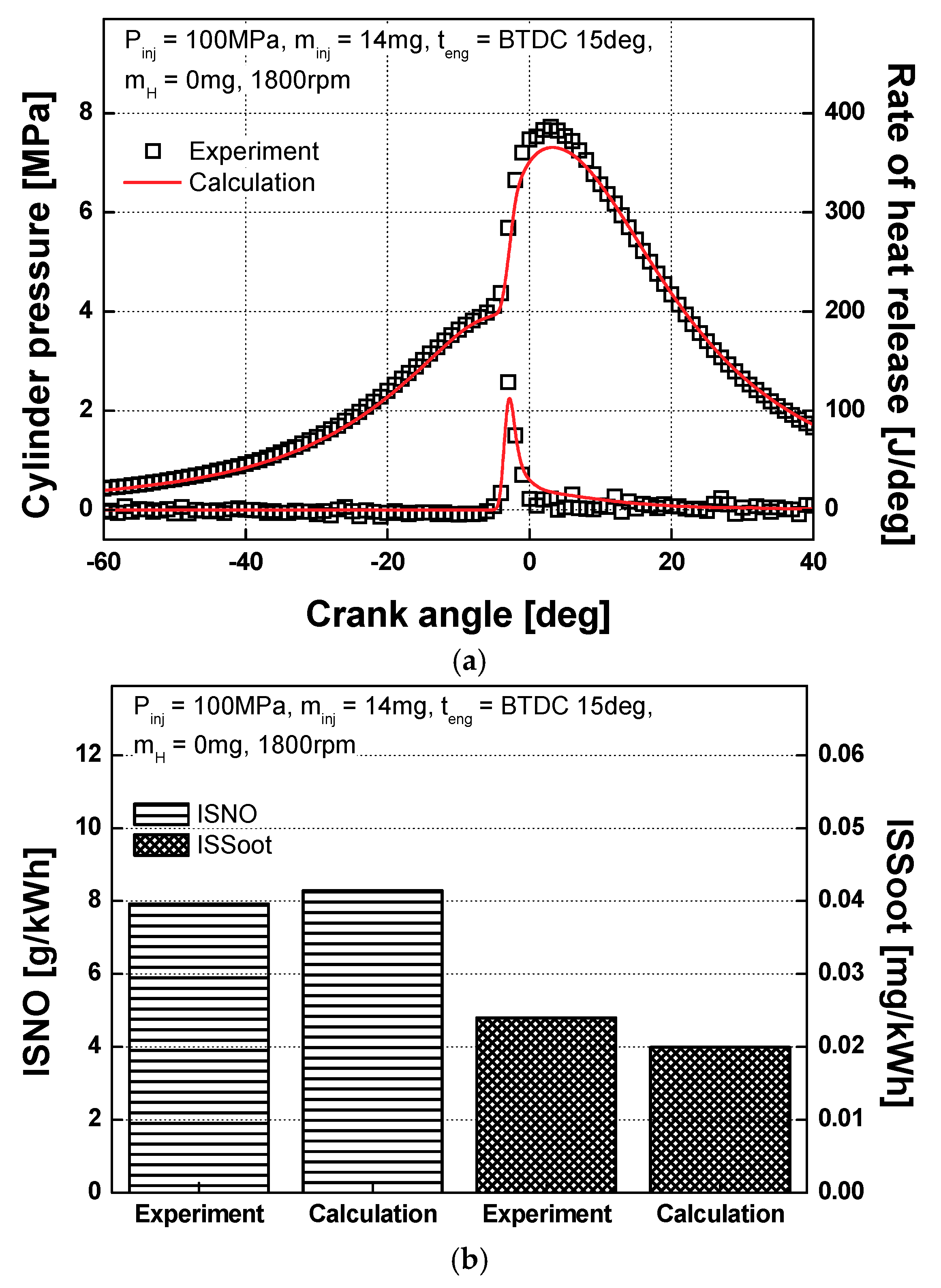

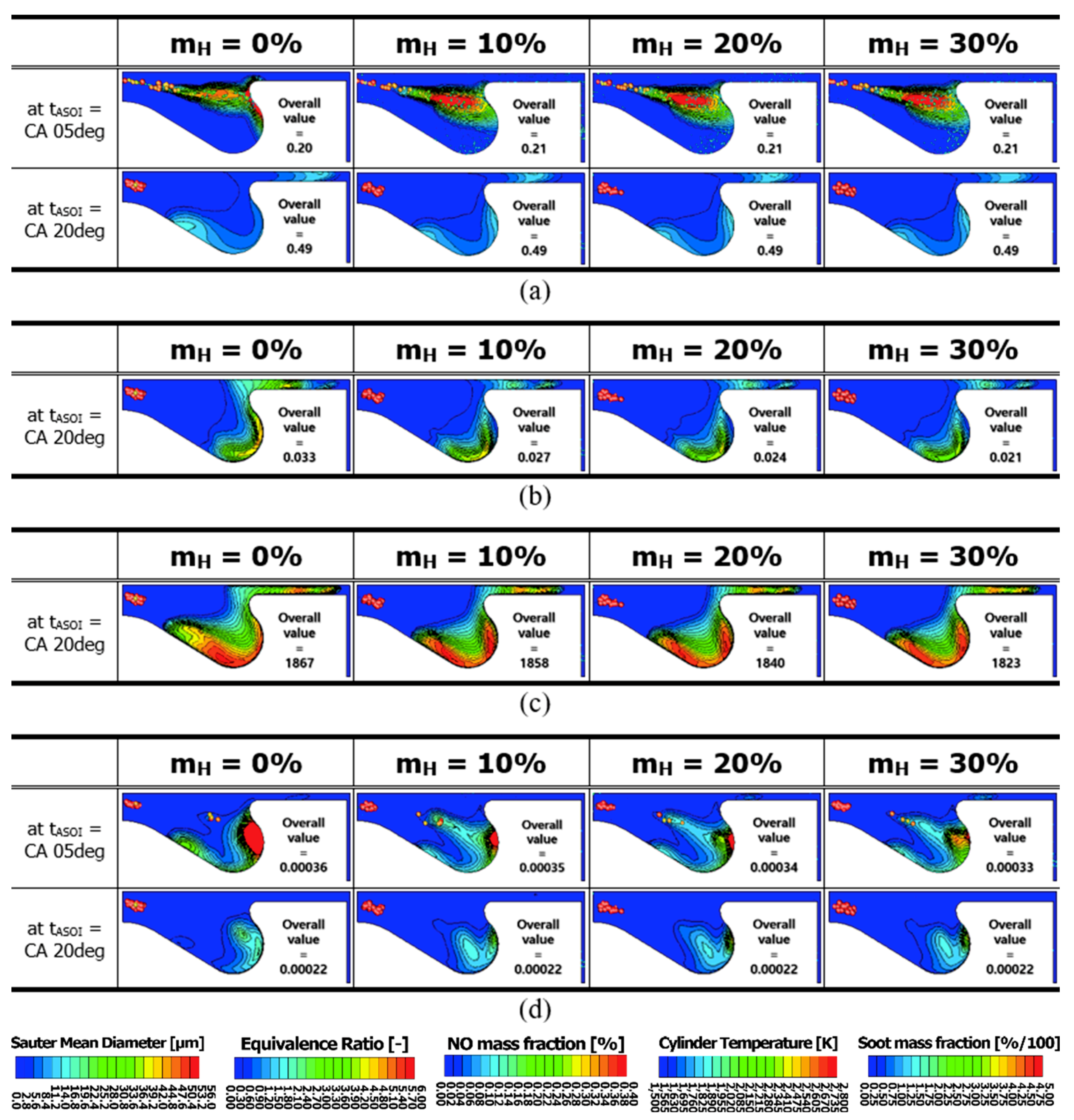
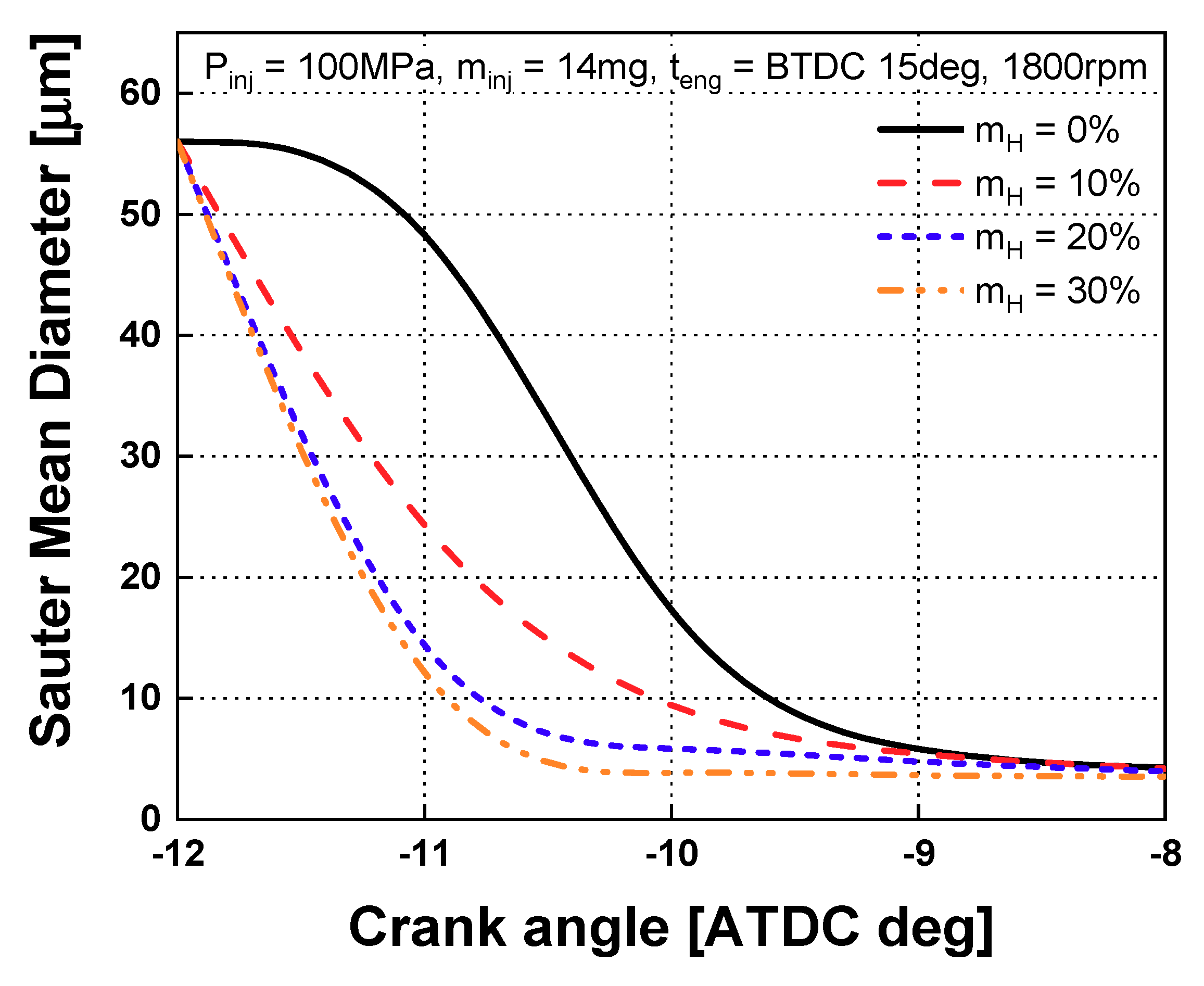




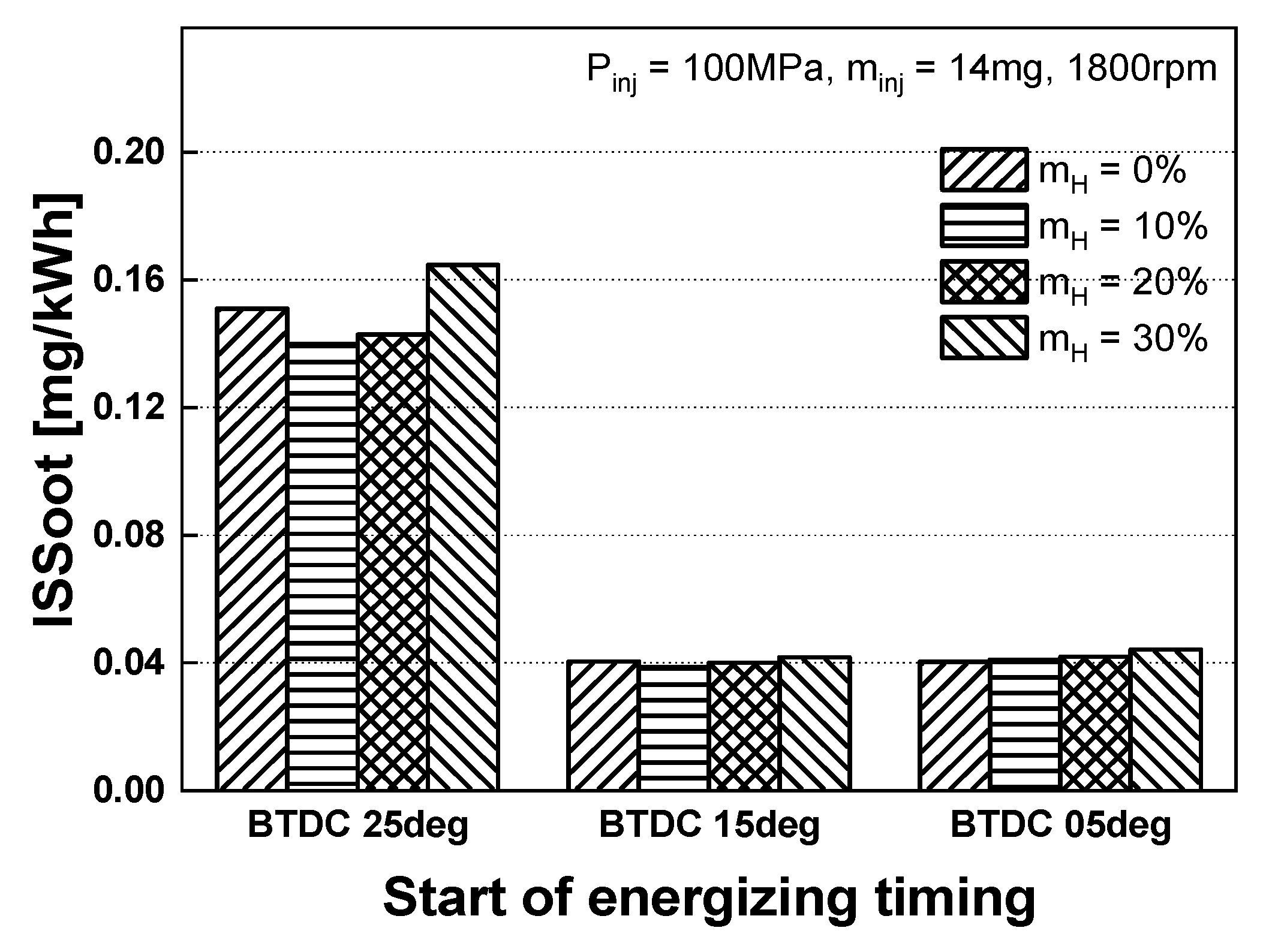


| Item | Specification | |
|---|---|---|
| Engine | Bore Stoke | 83 mm 92 mm |
| Displacement | 498 cc | |
| Compression ratio | 17.7 | |
| Injector | Nozzle | 5 hole mini-sac type |
| Hole diameter | 0.168 mm | |
| Injection angle | 154deg | |
| Emission Measuring Device | Item | Explanation |
|---|---|---|
| MAXA 9100D-EGR (NOX) | Method | CLD (CLA-150) |
| Range | 0~10,000 ppm | |
| Linearity | ±1.0% of full scale | |
| Response | ±1.0% of full scale | |
| CPC 3772 | Theoretical size range | 7.23~710.5 |
| Dilution ratio | 110:1 | |
| Heating temperature | 190 °C |
| Phenomenon | Model |
|---|---|
| Turbulence | k-zeta-f |
| Break-up | Wave |
| Evaporating | Multi-component |
| Wall interaction | Walljet1 |
| Combustion | ECFM-3Z |
| NO | Extended Zel’dovich |
| Soot | Kennedy-Hiroyasu-Magnussen |
| RPM | 1800 |
| Injection pressure [MPa] | 100 |
| Injection mass [mg] | 14 |
| Start of energizing timing [ATDC deg] | −20, −15, −10, −5 |
| Water vapor portion [%] | 10, 20, 30 |
© 2019 by the authors. Licensee MDPI, Basel, Switzerland. This article is an open access article distributed under the terms and conditions of the Creative Commons Attribution (CC BY) license (http://creativecommons.org/licenses/by/4.0/).
Share and Cite
Min, S.H.; Suh, H.K. Effect of Water Vapor Injection on the Distributions of Equivalence Ratio and the NO Emission Reduction in a CI Engine. Energies 2019, 12, 4248. https://doi.org/10.3390/en12224248
Min SH, Suh HK. Effect of Water Vapor Injection on the Distributions of Equivalence Ratio and the NO Emission Reduction in a CI Engine. Energies. 2019; 12(22):4248. https://doi.org/10.3390/en12224248
Chicago/Turabian StyleMin, Se Hun, and Hyun Kyu Suh. 2019. "Effect of Water Vapor Injection on the Distributions of Equivalence Ratio and the NO Emission Reduction in a CI Engine" Energies 12, no. 22: 4248. https://doi.org/10.3390/en12224248
APA StyleMin, S. H., & Suh, H. K. (2019). Effect of Water Vapor Injection on the Distributions of Equivalence Ratio and the NO Emission Reduction in a CI Engine. Energies, 12(22), 4248. https://doi.org/10.3390/en12224248



